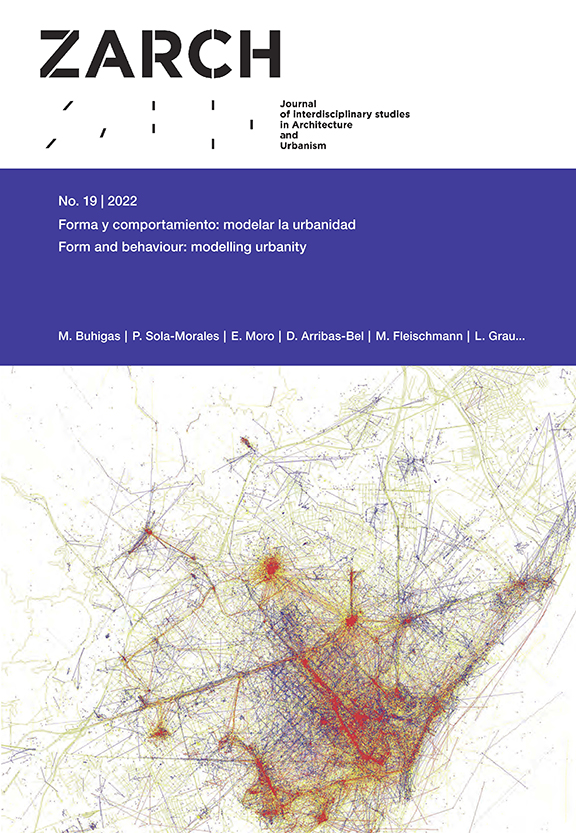Contributions of space syntax to research on the morphological and social history of urban space: the cases of Morella and Montblanc
DOI:
https://doi.org/10.26754/ojs_zarch/zarch.2022196927Keywords:
Space Syntax, Medieval City, Urban Form, Human Behaviour, Use of SpaceAbstract
The principal aim of this article is to explore the contributions of space syntax to historical research on the interactive relationship between the urban form and the social use of space. The article develops this subject and explores the spatial structure of the walled areas of Morella and Montblanc, with an emphasis on the entrance gates. The theory and methods of space syntax are applied to current urban planning and ancient plans of the two cities, and the analytical information extracted is contrasted with ethnographic observations and historical documents to provide context and solve ambiguities. The results of the analysis in Morella show that when one of the city's entrance gates disappears the spatial culture of the place changes completely; nonetheless, the social history is inscribed in the morphological history. In the case of Montblanc, studying the evolution of the urban form provides new information on the cultural significance of the wall's entrance gates in the city of the past. As this work concludes, space syntax is making significant contributions to research on the morphological history and the social history of urban space. These contributions may have direct consequences for design decisions in the recovery and/or management of heritage.
Display downloads
References
Al Sayed, K., Turner, A., y Hanna, S. 2009. Cities as emergent models. The morphological logic of Manhattan and Barcelona. En Proceedings of the 7th International Space Syntax Symposium, Stockholm: KTH, 001: 1-12.
Arnaiz, M., Ruiz, B., y Ureña, J. M. de. 2013. El análisis de la traza mediante Space Syntax. Evolución de la accesibilidad configuracional de las ciudades históricas de Toledo y Alacalá de Henares, ZARCH 1:128-140.
Beltran, J. 2019. Una historia de Morella a partir de la memoria viva de la forma urbana. En Arquitectura y conocimiento I, 169-195, Barcelona: Iniciativa Digital Politècnica.
Ferreira, P. 2021. Análisis comparativo de ciudades históricas mediante sintaxis espacial. Los casos de Sevilla y Lisboa, Arqueología de la Arquitectura 18: e110. https://doi.org/10.3989/arq.arqt.2021.002
Gamundí Carceller, S. 2007. Nuestras calles. Morella: Ajuntament de Morella.
Griffiths, S. 2021. Writing the Materialities of the Past: Cities and the Architectural Topography of Historical Imagination. New York: Routledge.
Griffiths, S. 2012. The use of space syntax in historical research: current practice and future possibilities. En Proceedings of the 8th International Space Syntax Symposium, Santiago de Chile: PUC, 8193: 1-26.
Griffiths, S.; y Vaughan, L. 2020. Mapping spatial cultures: Contributions of space syntax to research in the urban history of the nineteenth-century city. Urban History, 47(3): 488-511. doi:10.1017/S0963926820000206
Hillier, B. 1996. Space is the machine: a configuration theory of architecture. Cambridge: Cambridge University Press.
Hillier, B. 1989. The architecture of the urban object. Ekistics 56: 5-21.
Hillier, B., y Hanson, J. 1984. The social logic of space. Cambridge: Cambridge University Press.
Hillier, B.; Leaman, A.; Stansall, P.; y Bedford, M. 1976. Space syntax. Environment and Planning B: Planning and Design 3, no. 2: 147-85.
Kostof, S. 1992. The City assembled: the elements of urban form through history. Boston: Little Brown; 2ª ed., London: Thames & Hudson, 2005.
Mumford, L. 2021. La ciudad en la historia: sus orígenes, transformaciones y perspectivas. Logroño: Pepitas de calabaza.
Pinho, P.; Oliveira, V. 2009. Combining different methodological approaches to analyze the Oporto metropolitan area. En Proceedings of the 7th International Space Syntax Symposium, Stockholm: KTH, 88: 1-13.
Saura, M. 2021. 3. Noves dades a l’entorn territorial del portal de Sant Francesc de Montblanc. Butlletí de la Reial Acadèmia Catalana de Belles Arts de Sant Jordi 34: 215-47.
Saura, M.; Muntañola, J.; Beltran, J.; Martínez, J.; Ameli, R.; Molarinho, S. 2021. The emerge of cities, in between the urban morphological studies, the design poetic achievements and the ethnometodological social surveys. En Building the new sense of place, 51-64, Barcelona: Iniciativa Digital Politècnica.
Saura, M.; Muntañola, J.; Ameli, R.; Martínez, J.; Beltran, J.; Molarinho, S. 2021. Spatial syntax and the poetic spatial link in architecture and planning. En Building the new sense of place, 27-46, Barcelona: Iniciativa Digital Politècnica.
Downloads
Published
Issue
Section
How to Cite
Accepted 2022-10-06
Published 2023-02-11





